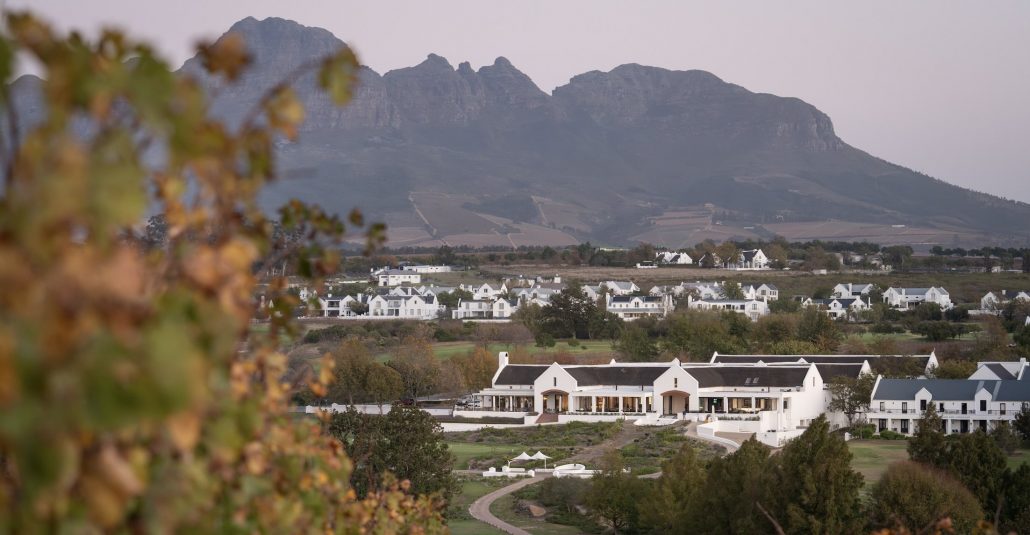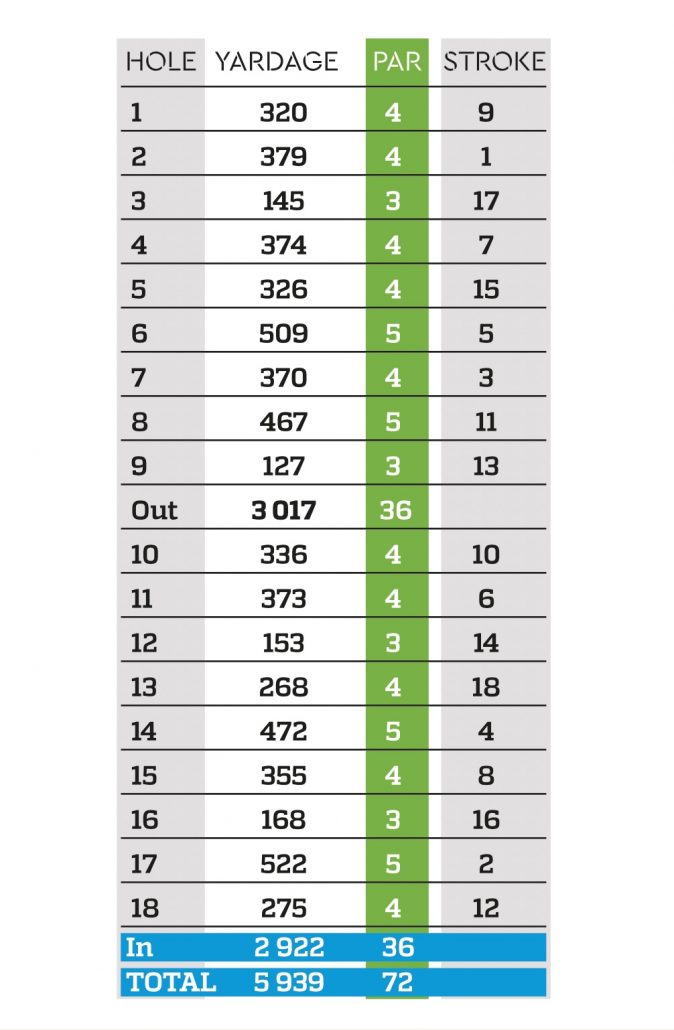De Zalze Golf Club can best be described as a mature parkland layout within the safe confines of a housing estate, writes MARK SAMPSON. An abundance of mature trees, vineyards and small wildlife abounds.
The area is rich in history with certain historic buildings dating back to 1838 still present on the land.
The current estate dates back to 1995 when the three farmers originally owning the land decided to build a golf course. It was then that well-known course architect Peter Matkovich was contracted for the design and construction got under way in 1996.
In November 2000, Spier Country Club opened its doors for the first time to the public. The name was taken from the Spier Group, which owned the neighbouring wine farm and had invested in the property that included the golf course.
In 2003, when the newly completed clubhouse opened, the name was changed to De Zalze Golf Club in line with the newly launched De Zalze Winelands Golf Estate development. An entire housing complex was mapped out around the course and with the combination of natural waterways, surrounding mountains and vineyards the estate was destined for success.
The name De Zalze was derived from a combination of the names of the original three farms: Kleine Zalze, Groote Zalze and De Vleie. Kleine Zalze still exists and the well-known wine brand’s vineyards can be seen around the estate on a number of holes with approximately 30% of the land used for winemaking. Behind the 1st green you can see the working cellar of Kleine Zalze wines.
When the course opened in 2000 it was a pay-and-play facility. In 2002, Dave Hansen was appointed as the first managing director and in 2003 the first plots on the De Zalze Winelands Golf Estate were sold. The current clubhouse was opened in December 2003, with new upgrades of the clubhouse taking place in 2023.
From the original layout in 1996 the course has undergone multiple changes and upgrades. Much of the changes include additional bunkering and softening of bunker edges both for maintenance and playability purposes.
More recently, heavy storms coming through the area brought wind so strong that bunkers lost up to 80% of their sand. The club has seen this as an opportunity to do some maintenance on the bunkers and check the drainage systems below.
The course is not overly long, weighing in at 5 939m and so numerous bunkers, water hazards, mature trees and the wind help it maintain its integrity.
The course – due to its proximity to the coast – is susceptible to local winds in the form of the south-easter and south-wester.
Mature treelined fairways can be expected on several of the holes with water present on no less than 10 holes. Two main water-holding dams come into play on the 6th and 12th/13th holes while the Blaauklippen River navigates its way through the course, coming into play on five holes.
While not the largest in the country, the bent grass greens have ample subtle sloping, demanding your attention. Most are also well protected by bunkers.
The course has a variety of accessible short par fours as well as some short par threes with the 127m 9th the shortest on the course. You can expect a mix of tight holes as well as wide-open expansive fairways. As the course is set in a valley, the holes closer to the river are generally a lot tighter and demanding off the tee with those higher up more forgiving.
The opening three holes play along the river away from the clubhouse. The 1st is a short par four of 320m sliding from left to right with the river along the entire right side. Two well-placed bunkers left await the errant tee shot. A decent drive will leave you anything from 130m or less out. The two-tiered green is well protected by a bunker left and a pair on the right. The large surface will give you an idea of what to expect for the rest of the day from the subtly contoured greens.
The 2nd is a relatively straight par four with the hole tucked away slightly right of the incoming fairway. Playing to 379m in length will leave a long-iron into a green with swales coming off the two bunkers left. If the wind is up, it adds to the demanding approach of this stroke one. Be sure to try to stay on the left side of the fairway.
The 3rd is a par three of only 145m. Playing over the river anything short will either be wet or land on large slabs of exposed rock making up part of the riverbed. Both options are not advisable. Thoughts of over-clubbing should also be abandoned as the green slopes strongly from back to front. Crosswinds can be expected in this corner of the course.
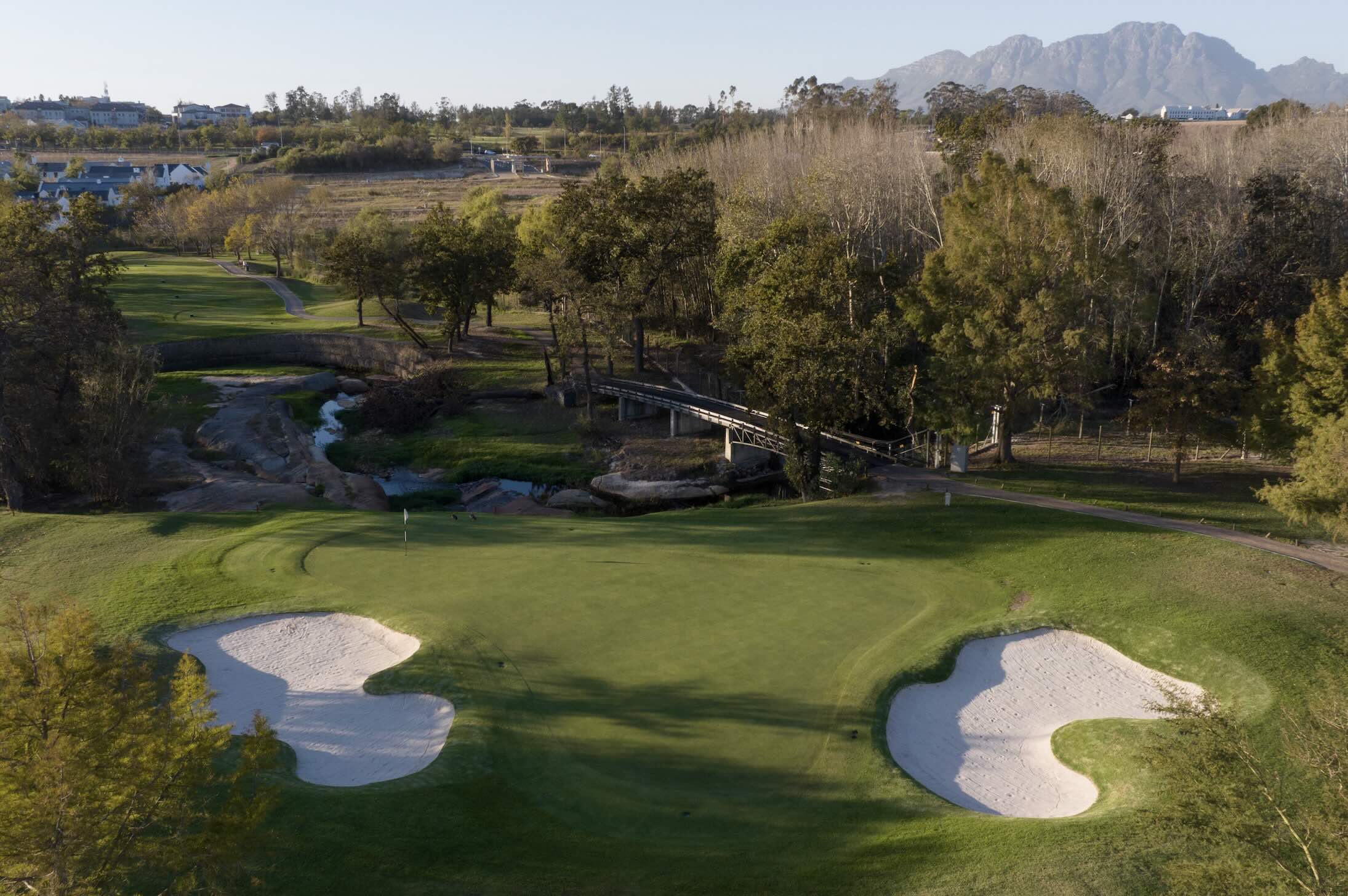
As the course reaches higher ground the following holes, although well bunkered, have much more forgiving landing areas. The 6th hole is your first par five of the day playing to a length of 509m. The large water hazard down the right side grabs your attention from the tee box. A buffer of rough off the left side allows for a bit of a bailout but any further and you will end up in some of the local vines. Nearing the hole, two bunkers short keep you true if laying up, while green-side another two bunkers right encroach into the green.
The second par five of the nine comes at the 8th, playing to a much more enticing 467m. The hole slides downhill from right to left, with a good drive leaving the longer hitters an opportunity of going for the green in two. It is a great risk-reward hole, especially as the tee shot is blind. The two fairway bunkers left are good aids in the tiger line just right of them.
The par-three 9th is another short hole of only 127m. It is by no means a pushover as the drop in elevation from tee to green, water short and a steep drop-off over the back does make club selection tricky. Beware if the wind is helping from behind.
Much of the same can be expected on the back nine at De Zalze Golf Club with a selection of low-lying tight holes and a number of high-level holes that are more open and ‘forgiving’.
The 10th is a par four of 336m, a dogleg left to an elevated green. The tee shot is fraught with danger as three bunkers are well placed left of the landing area, which is very narrow. Anything right will find trees and ultimately out of bounds. The heart-shaped green is only 22m deep, so finding the surface can prove challenging.
The second large dam on the course makes for a stunning turn on holes 12 and 13. The 12th is a great hole of only 153m with the dam as a backdrop and wooden walkways rising from the dam to the following hole making for a very picturesque setting. Beware of crosswinds to this well-bunkered green with water right.
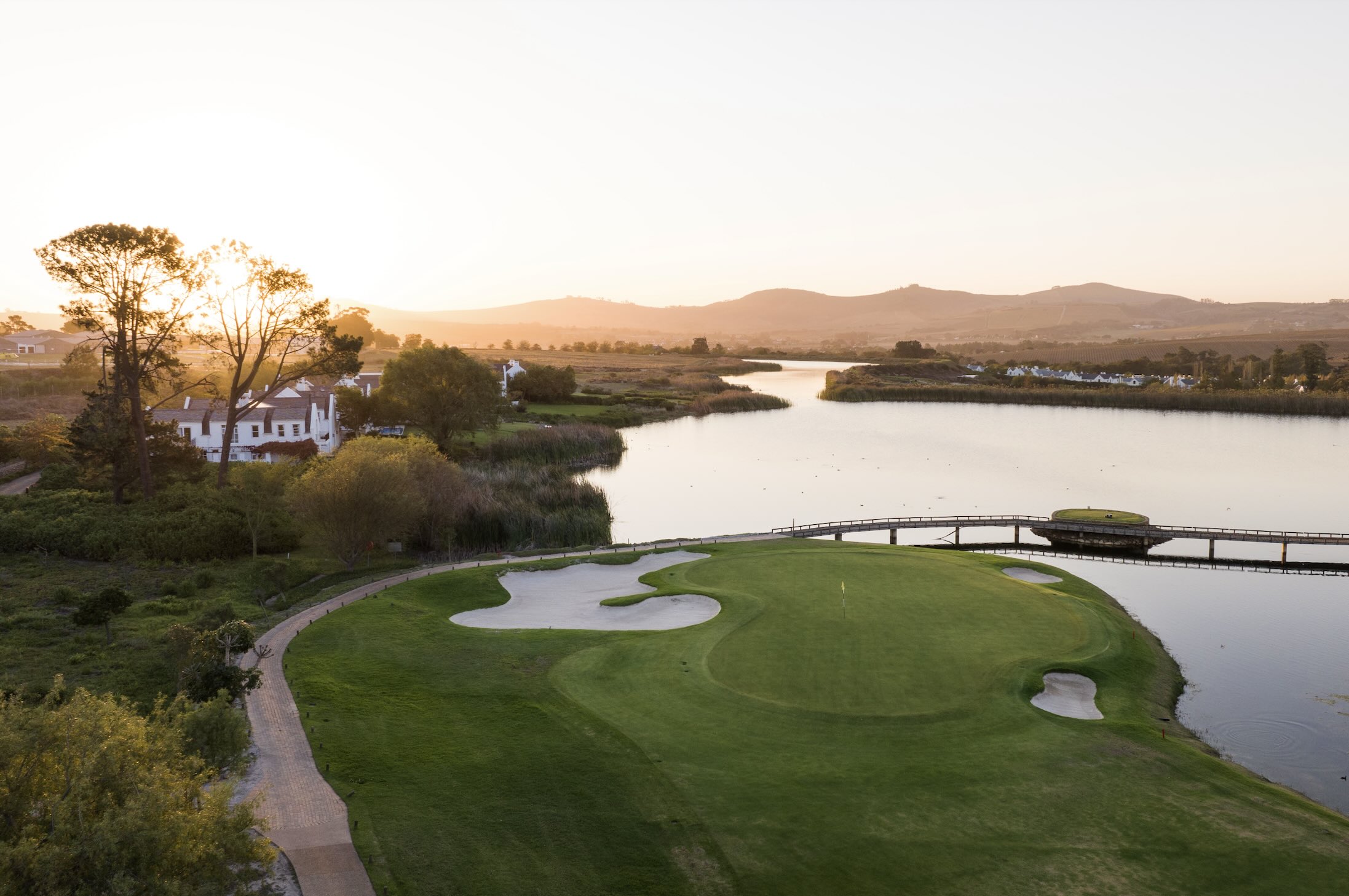
The 13th is a fine risk-and-reward Matkovich-designed hole and the signature hole on the course (see below).
Thereafter the course cuts back and forth as it moves back down to the lower holes beside the Blaauklippen River. Take note of the vineyards and olive trees in the area, something very few courses can boast.
The 17th is a testing hole of 522m. When the south-easter is up, a true test of ball-striking and good yardage management is needed. Very few golfers will be able to make it up in two and the wise play is to leave your happy yardage for the approach over water. The hole bends left initially and then right before crossing the river to a large green. It is one of the few holes on the course without a bunker. The stroke-two indicator confirms length is the main protection of this hole. A par on this hole is a great score.
The closing hole is as unique as the course itself. Playing from a raised tee, it is 275m to the surface of the green. Don’t be fooled by the stroke-16 rating as this hole is deserving of all your attention. It’s more suited for the Bryson DeChambeaus out there who have a good understanding of yardages and drops in elevation and can calculate the correct club from the tee.
While the green may be in range for some, the Blaauklippen cuts just in front of it and another water hazard over the back left is well placed.
The unique nature of the hole is owed to the large oak tree placed directly in the line of where a well-hit drive will end up. It is for this reason the correct calculation for the tee is made to allow for a direct line of approach to the green. And so while the hole length is 275m, the magical number is 204m from the tee. Anything else may see your line to the hole compromised. A memorable closing hole before heading up to the newly renovated clubhouse.
Overlooking the practice green, driving range and 18th green, the expansive layout of the clubhouse can accommodate any group size. At sunset, the surrounding vineyards and mountains make for a backdrop befitting of this iconic Matkovich layout with the verandah the perfect location to enjoy a well-deserved cold beverage.
SIGNATURE HOLE
13th hole, par four, 268m
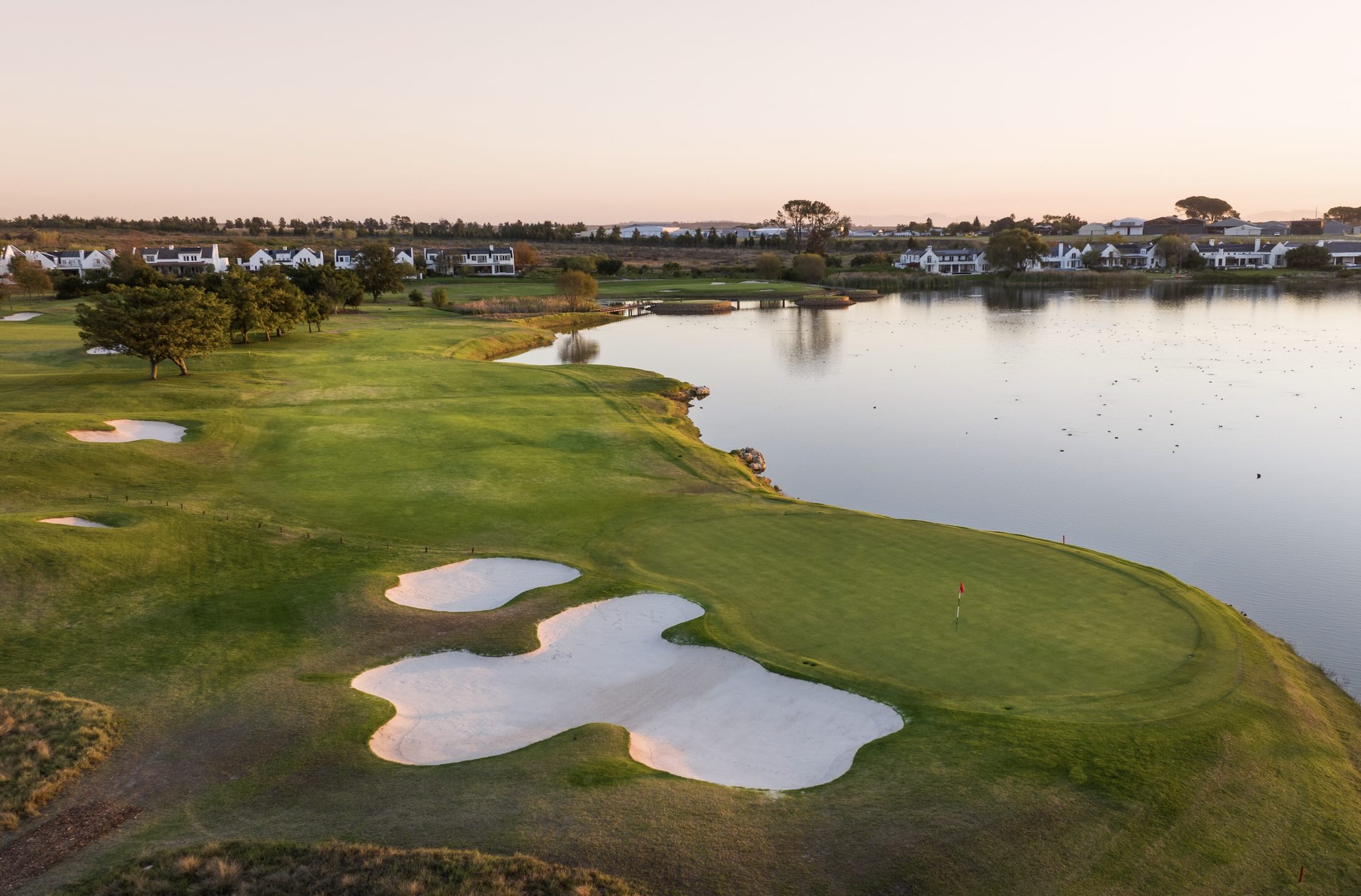
The par-four 13th at De Zalze Golf Club must be one of the most iconic par fours in South Africa. Not only for its playability but also the beauty of the hole as it meanders tantalisingly close to the water hazard from tee to green. It’s a hole you can play a dozen times and still return to with great anticipation each time.
Being the stroke 18 on the course, it isn’t too tough and offers a carrot to every level of golfer in its risk/reward nature. From tee to green it covers 268m requiring a 150m carry to the main part of the fairway. Placed higher than the other holes on the back nine, it is exposed to any wind that may be up.
The south-wester will help you reach the green, while the south-easter will push your ball from right to left towards the water hazard.
The fairway curves from right to left along the water hazard before reaching the green, giving you numerous angles of attack.
It’s all about knowing the yardage of your clubs and making sure you cover the water hazard while avoiding two fairway bunkers well placed at 211m and 225m from the tee box.
The question is: have you left your favourite yardage to the flag? Bearing in mind water awaits if you go long on your approach and depending on how aggressive you are from the tee, your approach may be from the side of the green which is only 15m wide with water along the left and back.
The green has very few strong contours and is slightly raised from back to front, offering a genuine two-putt par.
A delicious hole serving up a multitude of options.
GREENFEES
Members: R170 9 holes R335 18 holes
Scholars: R80/9 R175/18 (week), R165/9 R250/18 (weekend)
Affiliated Guests: R355/9 R675/18
Non affiliated: R565/9 R880/18
Golf Cart: R270/9 R530/18
ADDRESS
R44, De Zalze Golf Estate,
Stellenbosch, 7600
ROAD DISTANCES
Cape Town: 50km
Bloemfontein: 978km
Durban: 1,612km
Johannesburg: 1,374km
CONTACT DETAILS
Email: [email protected]
Website: www.dezalzegolf.com
Phone: (021) 880-7300
– This article first appeared in the June 2024 issue of Compleat Golfer magazine.
Photos: Mark Sampson


